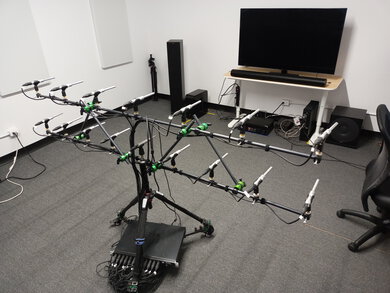If you like to feel immersed in your audio content, you'll want a soundbar with a wide, focused soundstage. A soundstage is the 'stage' for your audio or an imaginary three-dimensional space that makes up the height, width, and depth of your audio image. Another way to understand soundstage is to imagine that you've dropped into the middle of your favorite movie. Dialogue, footsteps, and explosions are taking place around you, and even if you closed your eyes, you would still be able to understand where the action is taking place. A good soundstage performance can help accurately pinpoint sound objects. This allows you to feel like the movie you're watching takes place around you in your living room.
We test for a couple of factors that influence a soundbar's soundstage performance: the perceived width and focus of the soundstage, as well as the amount of crosstalk error.
Test results
When It Matters
If you like to listen to music and watch movies, a soundbar with a good soundstage performance can help you feel more immersed in your audio. A wide, natural-sounding soundstage adds more height, width, and depth to your audio image. Additionally, a soundstage with good focus helps to separate instruments and sound effects by accurately localizing them to a pinpoint location, rather than making it seem like they come from a more general area. As a result, audio seems like it's coming from all around you, rather than from a speaker placed in front of you.
Our Tests
 To measure a soundbar's soundstage, our testing team assigns a subjective score based on the perceived width and focus of the soundstage. First, our team identifies the perceived width of the soundstage by comparing its perceived size to the testing table. Then, we play a sound file with a moving noise to determine whether sound objects seem to come from an accurate, focused location or a more general area. They also perform a crosstalk error test, though we don't score this. We only test for the bar's stereo soundstage, so the surround channels aren't taken into account for this test.
To measure a soundbar's soundstage, our testing team assigns a subjective score based on the perceived width and focus of the soundstage. First, our team identifies the perceived width of the soundstage by comparing its perceived size to the testing table. Then, we play a sound file with a moving noise to determine whether sound objects seem to come from an accurate, focused location or a more general area. They also perform a crosstalk error test, though we don't score this. We only test for the bar's stereo soundstage, so the surround channels aren't taken into account for this test.
We perform our soundstage tests during our stereo frequency response accuracy and stereo dynamics testing. We use a 20' (L) x 16' (W) x 9.5' (H) room, with one couch and minimal sound treatment to better represent a typical living room. We place the soundbar on a table that's 7.5 feet away from our microphone array. We use a laser measuring tool to ensure that the microphone array, the table, and the soundbar are at the appropriate distance from the side walls, as well as the subwoofer and the satellites if they're included in the setup.
Crosstalk Error
In a stereo setup, content plays from the left and right channels of the soundbar. Some of the sound from the left speaker goes towards the right ear and vice versa, creating a certain crosstalk pattern. Crosstalk can help remove the illusion of a "hole" within the stereo image, resulting in a more clear and focused phantom center. However, some soundbars have too much crosstalk. Compared to loudspeakers, which are considered the reference for crosstalk measurements, soundbars have a shorter distance between the left and right drivers, and the drivers are usually at less of an angle. As a result, they may have a very focused phantom center, but their soundstage may be perceived as very small and narrow.
 The Bose Soundbar 700 has a crosstalk error value of 1.59 dB. There's little deviation between the soundbar's crosstalk and the target crosstalk.
The Bose Soundbar 700 has a crosstalk error value of 1.59 dB. There's little deviation between the soundbar's crosstalk and the target crosstalk. The LG SN11RG has a much higher crosstalk error value of 5.52 dB. There's a lot of deviation, especially in the treble range.
The LG SN11RG has a much higher crosstalk error value of 5.52 dB. There's a lot of deviation, especially in the treble range.Ultimately, the crosstalk error value represents the average deviation of the soundbar's crosstalk from the predetermined target crosstalk. This is obtained from our tests performed with loudspeakers from German manufacturer ELAC. We perform this test using a dummy head. A low amount of crosstalk error typically represents a wider speaker-like soundstage. While crosstalk error isn't scored, it can give you a better understanding of how natural-sounding the soundstage is perceived to be and whether or not the bar has good instrument separation.
Conclusion
A soundstage is a three-dimensional space that represents the width of the audio image as you perceive it. A wider and more focused soundstage can improve your audio listening experience by making it seem like sound objects like voices and footsteps are coming from a pinpoint location rather than from a more general area. Also, a low amount of crosstalk error represents a soundstage that can accurately separate instruments for a more speaker-like sound. Ultimately, a good soundstage performance is especially useful for fans of music and movies who want an immersive sound.